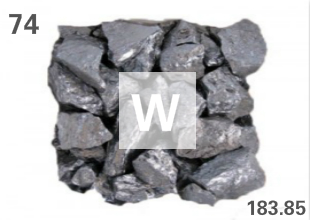Chemical properties of Tungsten
- Atomic number:
- 74
- Atomic mass:
- 183.84 g.mol -1
- Electronegativity according to Pauling:
- 2.36
- Density:
- 19.25 g.cm-3
- Melting point:
- 3422 °C
- Boiling point:
- 5930 °C
- Atomic radius:
- 139pm
- Electronic shell:
- [ Xe ] 4f14 5d4 6s22
- Energy of first ionisation:
- 775 kJ.mol -1
Tungsten, also known as wolfram, is a chemical element with symbol W and atomic number 74. tungsten's many alloys have numerous applications, including incandescent light bulb filaments, X-ray tubes (as both the filament and target), electrodes in TIG welding, superalloys, and radiation shielding. Tungsten's hardness and high density give it military applications in penetrating projectiles. Tungsten compounds are also often used as industrial catalysts. Tungsten is the only metal from the third transition series that is known to occur in biomolecules, where it is used in a few species of bacteria and archaea.
Applications
Tungsten is mainly used in the production of hard materials based on tungsten carbide, one of the hardest carbides, with a melting point of 2770 °C. Tungsten, usually alloyed with nickel and iron or cobalt to form heavy alloys, is used in kinetic energy penetrators as an alternative to depleted uranium, in applications where uranium's radioactivity is problematic even in depleted form, or where uranium's additional pyrophoric. Applications requiring its high density include weights, counterweights, ballast keels for yachts, tail ballast for commercial aircraft, and as ballast in race cars for NASCAR and Formula One; depleted uranium is also used for these purposes, due to similarly high density.
Tin is produced by carbothermic reduction of the oxide ore with carbon or coke. Both reverberatory furnace and electric furnace can be used. Cases of poisoning from tin metal, its oxides, and its salts are "almost unknown". On the other hand, certain organotin compounds are almost as toxic as cyanide.
Tungsten in the environment
Because tungsten is rare[clarification needed] and its compounds are generally inert, the effects of tungsten on the environment are limited. The median lethal dose LD50 depends strongly on the animal and the method of administration and varies between 59 mg/kg (intravenous, rabbits) and 5000 mg/kg (tungsten metal powder, intraperitoneal, rats). People can be exposed to tungsten in the workplace by breathing it in, swallowing it, skin contact, and eye contact. The National Institute for Occupational Safety and Health(NIOSH) has set a recommended exposure limit (REL) of 5 mg/m3 over an 8-hour workday and a short term limit of 10 mg/m3.
Applications
Tungsten is mainly used in the production of hard materials based on tungsten carbide, one of the hardest carbides, with a melting point of 2770 °C. Tungsten, usually alloyed with nickel and iron or cobalt to form heavy alloys, is used in kinetic energy penetrators as an alternative to depleted uranium, in applications where uranium's radioactivity is problematic even in depleted form, or where uranium's additional pyrophoric. Applications requiring its high density include weights, counterweights, ballast keels for yachts, tail ballast for commercial aircraft, and as ballast in race cars for NASCAR and Formula One; depleted uranium is also used for these purposes, due to similarly high density.
Tin is produced by carbothermic reduction of the oxide ore with carbon or coke. Both reverberatory furnace and electric furnace can be used. Cases of poisoning from tin metal, its oxides, and its salts are "almost unknown". On the other hand, certain organotin compounds are almost as toxic as cyanide.
Tungsten in the environment
Because tungsten is rare[clarification needed] and its compounds are generally inert, the effects of tungsten on the environment are limited. The median lethal dose LD50 depends strongly on the animal and the method of administration and varies between 59 mg/kg (intravenous, rabbits) and 5000 mg/kg (tungsten metal powder, intraperitoneal, rats). People can be exposed to tungsten in the workplace by breathing it in, swallowing it, skin contact, and eye contact. The National Institute for Occupational Safety and Health(NIOSH) has set a recommended exposure limit (REL) of 5 mg/m3 over an 8-hour workday and a short term limit of 10 mg/m3.



